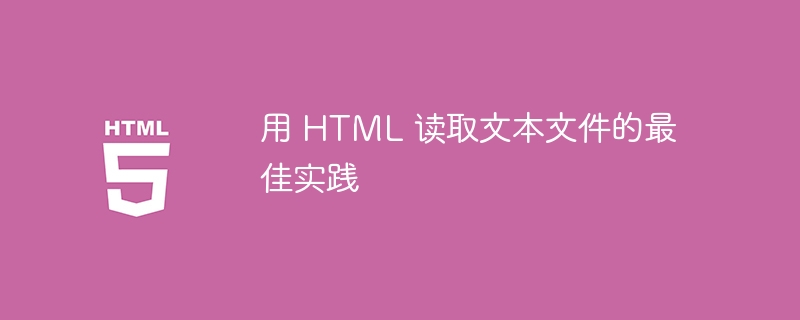Best practices for reading text files with HTML
Text files can be read through HTML using the element and utilizing the FileReader API. Best practices include using the accept attribute to filter file types, leveraging the multiple attribute to select multiple files, and reading files through the onchange event handler. A practical case demonstrates how to read a text file and display its content, using the readAsText() method of FileReader to load the file content into a variable.

Reading text files with HTML: Best practices & practical cases
Reading text files with HTML can be done through<input type= "file"> element implementation, which allows the user to select a file to read.
<input type="file" id="file-input">
Best Practice:
- Use the
acceptattribute to filter file types: For example,accept=".txt,.csv" - Use the
multipleattribute to select multiple files:multiple - Handling files: Use the
onchangeevent handler to obtain and read files. - Use
FileReaderAPI:FileReaderAPI provides methods to read file content, such asreadAsText() - Consider security: Read only known and trusted files that users upload to your server.
Practical case:
Read a text file and display its content:
<input type="file" id="file-input">
<script>
const input = document.getElementById('file-input');
input.addEventListener('change', function() {
const file = input.files[0]; // 获取第一个文件
const reader = new FileReader();
reader.onload = function() {
const text = reader.result; // 已读取的文件内容
// 在此使用 `text` 变量
};
reader.readAsText(file);
});
</script>The above code allows the user to select a text file and Loads its contents into a text variable, which can be used for further processing (for example, display, parsing, or storage).
The above is the detailed content of Best practices for reading text files with HTML. For more information, please follow other related articles on the PHP Chinese website!

Hot AI Tools

Undresser.AI Undress
AI-powered app for creating realistic nude photos

AI Clothes Remover
Online AI tool for removing clothes from photos.

Undress AI Tool
Undress images for free

Clothoff.io
AI clothes remover

AI Hentai Generator
Generate AI Hentai for free.

Hot Article

Hot Tools

Notepad++7.3.1
Easy-to-use and free code editor

SublimeText3 Chinese version
Chinese version, very easy to use

Zend Studio 13.0.1
Powerful PHP integrated development environment

Dreamweaver CS6
Visual web development tools

SublimeText3 Mac version
God-level code editing software (SublimeText3)

Hot Topics
 1384
1384
 52
52
 Table Border in HTML
Sep 04, 2024 pm 04:49 PM
Table Border in HTML
Sep 04, 2024 pm 04:49 PM
Guide to Table Border in HTML. Here we discuss multiple ways for defining table-border with examples of the Table Border in HTML.
 HTML margin-left
Sep 04, 2024 pm 04:48 PM
HTML margin-left
Sep 04, 2024 pm 04:48 PM
Guide to HTML margin-left. Here we discuss a brief overview on HTML margin-left and its Examples along with its Code Implementation.
 Nested Table in HTML
Sep 04, 2024 pm 04:49 PM
Nested Table in HTML
Sep 04, 2024 pm 04:49 PM
This is a guide to Nested Table in HTML. Here we discuss how to create a table within the table along with the respective examples.
 HTML Table Layout
Sep 04, 2024 pm 04:54 PM
HTML Table Layout
Sep 04, 2024 pm 04:54 PM
Guide to HTML Table Layout. Here we discuss the Values of HTML Table Layout along with the examples and outputs n detail.
 HTML Input Placeholder
Sep 04, 2024 pm 04:54 PM
HTML Input Placeholder
Sep 04, 2024 pm 04:54 PM
Guide to HTML Input Placeholder. Here we discuss the Examples of HTML Input Placeholder along with the codes and outputs.
 HTML Ordered List
Sep 04, 2024 pm 04:43 PM
HTML Ordered List
Sep 04, 2024 pm 04:43 PM
Guide to the HTML Ordered List. Here we also discuss introduction of HTML Ordered list and types along with their example respectively
 Moving Text in HTML
Sep 04, 2024 pm 04:45 PM
Moving Text in HTML
Sep 04, 2024 pm 04:45 PM
Guide to Moving Text in HTML. Here we discuss an introduction, how marquee tag work with syntax and examples to implement.
 HTML onclick Button
Sep 04, 2024 pm 04:49 PM
HTML onclick Button
Sep 04, 2024 pm 04:49 PM
Guide to HTML onclick Button. Here we discuss their introduction, working, examples and onclick Event in various events respectively.




